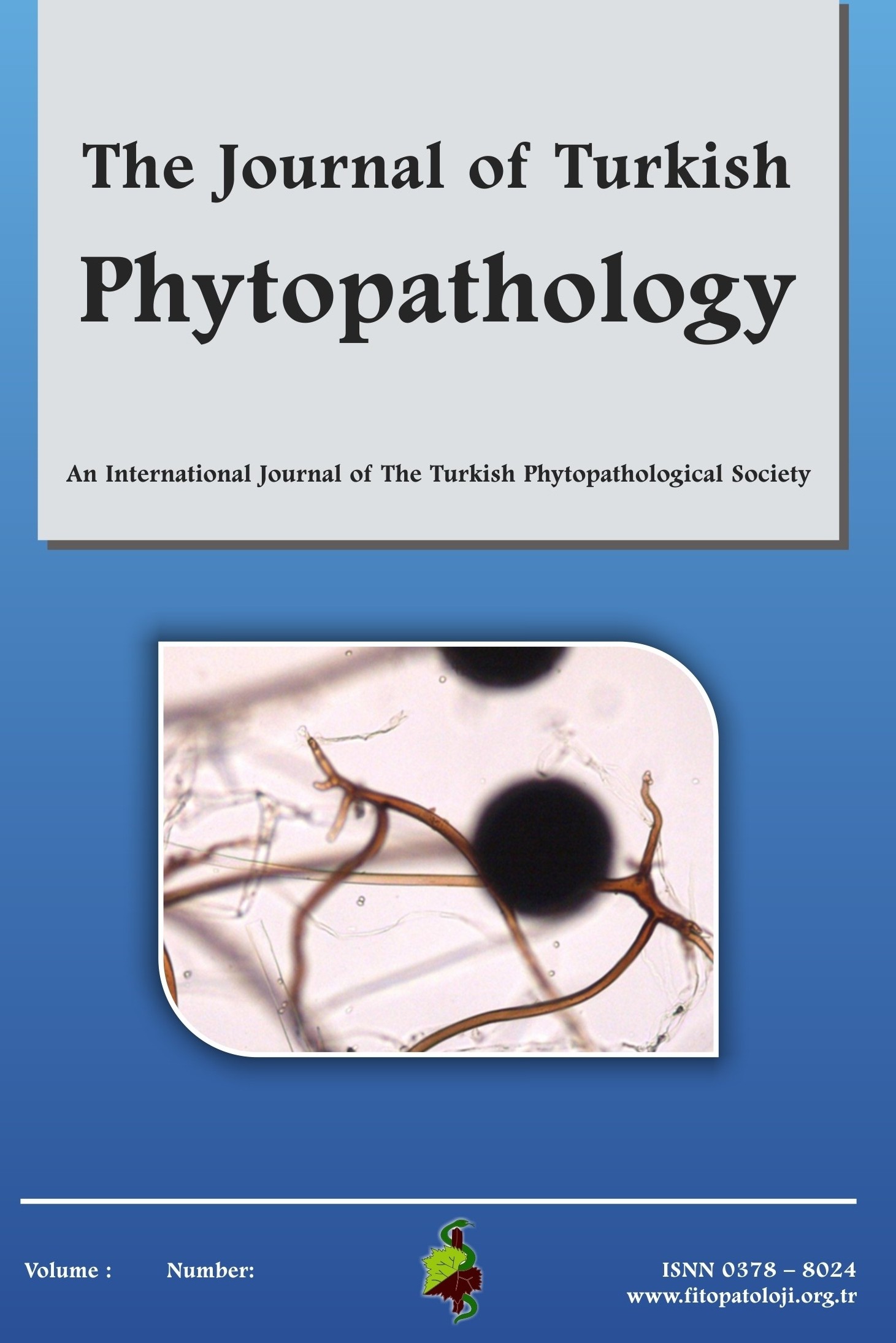Prevalence, Isolation and Identification of Bacterial Canker Pathogens on Sweet Cherry Trees in Tekirdağ
Prevalence, Isolation and Identification of Bacterial Canker Pathogens on Sweet Cherry Trees in Tekirdağ
Sweet cherry (Prunus avium L.) is one of the most important fruit
trees grown in Tekirdağ. Bacterial canker which
reduces yield and quality of sweet cherry
fruit and cause death of trees were investigated. For
this
purpose a survey study was conducted in 2012-2013 and 129 plant tissue samples were
collected from symptomatic trees. As a result of survey studies, bacterial canker
was determined in all orchards
and diseases prevalence rate of bacterial canker was determined
as 20-57%. Severity of disease was
measured as 20-85% in Tekirdağ Province
depending on orchards. As a
result of laboratory studies 41
bacterial isolates of Pseudomonas syringae
were obtained. As a result of classical and molecular identification tests, 23 isolates were identified as Pseudomonas
syringae pv.
morsprunorum and
18 out of 41 isolates were identified as a Pseudomonas syringae pv. syringae.
Keywords:
Cerasus avium, LOPAT, GATTa Pseudomonas syringae pv. syringae, Pseudomonas syringae pv. morsprunorum,
___
- Abbasi, V., Rahminian, H., Ghanbari, M. A. T. 2012. Genetic variability of Iranian strains of Pseudomonas syringae causing bacreial canker disease on stone fruits. Eur J Plant Pathol, 135: 225-235. Abbasi, V., Rahimian, H. and Tajick-Ghanbari, M. A. 2013. Genetic variability of Iranian strains of Pseudomonas syringae pv. syringae causing bacterial canker disease of stone fruits. European journal of plant pathology, 135: 225-235. Abelleira, A., Ares, A., Augin, O., Picoaga, A., Lopez, M. M., Mansilla, P. 2014. Current situation and characterization of Pseudomonas syringae pv. actinidae on kiwifruit in Galicia (northwest Spain).Plant Pathology, 691-699. Anonim 2008. Sert çekirdekli meyvelerde bakteriyel yanıklık hastalığı. Zirai Mücadele Teknik Talimatları, Ankara, Cilt 4, 66-68. Burak, M. 2003. Meyvecilik-1, 147-151. De Boer, S. H., Ward, L. J. 1995. PCR detection of Erwinia caratovora subsp. atroseptica associated with potato tissue. Phytopathology, 85:854-858. Ertimurtaş, D., Özaktan, H. 2014. Sert çekirdekli meyvelerde bakteriyel kansere neden olan Pseudomonas syringae pathovarlarının tanısı. Türkiye V. Bitki Koruma Kongresi, Antalya. Gavrilovic, V., Zivkovic, S., Dolovac, N., Trkulja, N., Dolovac, E. P., Popovic, T., Ivanovic, D., 2012. Pseudomonas syringae-pathogen of sweet cherry in Serbia. Pestic. Phytomed, 27(2): 141-149. Gerçekçioğlu, R., Bilginer, Ş., Soylu, A. 2006. Genel meyvecilik (Meyve yetiştiriciliği esasları kitabı). Görmez, A. 2011. Erzurum ilinde kayısı ağaçlarından izole edilen Pseudomonas türlerinin tanısı, karakterizasyonu ve çeşit reksiyonları. Doktora tezi, Atatürk Üniversitesi Fen Bilimleri Enstitüsü, Erzurum. Ivanovic, Z., Zivkovic, S., Starovic, M., Josic, D., Stankovic, S., Gavrilovic, V. 2009. Diversity among Pseudomonas syringae strains originating from fruit trees in Serbia. Arch. Biol. Sci., 61(4): 863-870. Janse, J. D. 1981. The bacterial disease of ash (Fraxinus excelsior), caused by Pseudomonas syringae subsp. savastanoi pv. fraxini. II. Etiology and taxonomic considerations. European Journal of Forest Pathology, 11: 425–38. Janse, J. D. 2006. Phytobacteriology. Principles and Practice. Wallingford, UK and Oxford Press, New York, 208-209. Jones, A. L., Sutton, T. B. 2006. Pseudomonas syringae pv. syringae and Pseudomonas syringae pv. morsprunorum. West Virginia University, 1-3. Kaluzna, M., Ferrante, P., Sobiczewski, P., Scortichini, M. 2010. Characterization and genetic diversity of Pseudomonas syringae from stone fruits and hazelnut using repetiyive-PCR and MLST. Journal of Plant Pathology, 92(3): 781-787. Kaluzna, M., Janse, J. D., Young, J. M. 2012. Detection and identification methods and new tests as used and developed in the framework of cost 873 for bacteria pathogenic to stone fruits and nuts. Journal of Plant Pathology, 94(1): 117-126. Kennely, M. M., Cazorla, F. M., Vicente, A., Ramos, C., Sundin, G. W. 2007. Pseudomonas syringae disease on fruit trees. Plant Disease, 91(1). Klement, Z., Rudolph, K., Sands, D. C. 1990. Methods in Phytobacteriology, Akademia Kiado, Budapest, XIV+568p. Lelliot, R. A., Stead, D. E. 1987. Methods for the Diagnosis of Bacterial Diseases of Plants. Oxford, UK: Blackwell Scientific Publications. Mirik, M., Baloğlu, S., Aysan, Y., Çetinkaya Yıldız, R., Küsek, M. and Şahin, F. 2005. First outbreak and occurrence of citrus blast disease, caused by Pseudomonas syringae pv. syringae on orange and mandarin trees in Turkey. Plant Pathology, 54 (2): 238. Ogawa, J. M., Zehr, E. L., Bird, G. W., Ritchie, D. F., Uriu, K. and Uyemoto, J. K. 1995. Compendium of stone fruit diseases, 78-87. Sambrook, J., Fritsch, E. F. and Maniatis, T. 1989. Molecular Cloning. A laboratory manual. 2nd ed. N.Y., Cold Spring Harbor Laboratory Press,1659 p. Schaad, N. W., Jones, J. B. and Chun, W. 2001. Laboratory Guide for Identification of Plant Pathogenic Bacteria. The American Phytopathological Society, St. Paul, MN., USA. TÜİK, 2013. www.tuik.gov.tr. Türkiye’de kiraz ağaç sayısı ve üretim miktarı. 23\07\2014.
- ISSN: 0378-8024
- Yayın Aralığı: Yılda 3 Sayı
- Başlangıç: 1971
- Yayıncı: Türkiye Fitopatoloji Derneği
